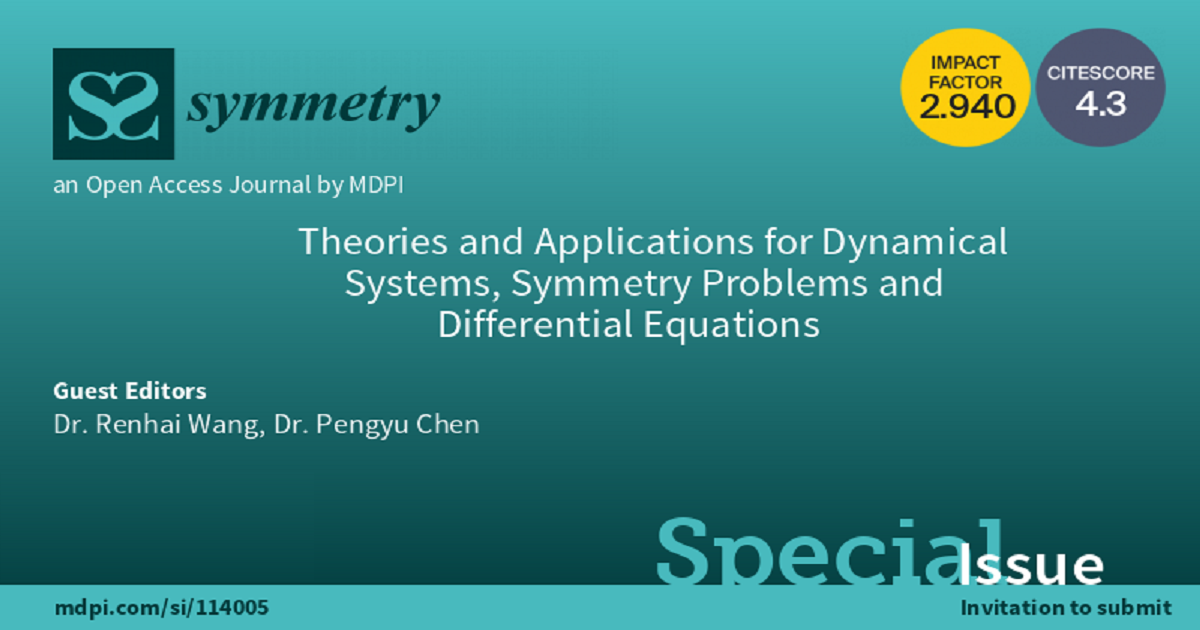Theories and Applications for Dynamical Systems, Symmetry Problems and Differential Equations
A special issue of Symmetry (ISSN 2073-8994). This special issue belongs to the section "Mathematics".
Deadline for manuscript submissions: closed (31 May 2023) | Viewed by 21437

Special Issue Editors
Interests: stochastic PDEs; fractional PDEs; lattice systems; well-posedness of PDEs; random dynamical systems; nonautonomous dynamical systems; pullback attractors; random attractors; invariant measures; large deviation principle; PDEs arriving from ocean, atmosphere and fluid
Special Issues, Collections and Topics in MDPI journals
Interests: stochastic PDEs, nonlinear analysis; fractional dynamics systems; nonlocal evolution equations; random dynamical systems; random attractors; operator semigroups; nonlocal differential equations with delay, PDEs for symmetry, numerical analysis
Special Issues, Collections and Topics in MDPI journals
Special Issue Information
Dear Colleagues,
Papers on any subjects related to symmetry problems, such as global attractors, pullback attractors, random attractors, invariant measures, large deviations, invariant manifolds, fractional calculus, traveling wave, lattice systems, and other topics related to dynamical systems and differential equations are welcome in this Special Issue.
Dr. Renhai Wang
Dr. Pengyu Chen
Guest Editors
Manuscript Submission Information
Manuscripts should be submitted online at www.mdpi.com by registering and logging in to this website. Once you are registered, click here to go to the submission form. Manuscripts can be submitted until the deadline. All submissions that pass pre-check are peer-reviewed. Accepted papers will be published continuously in the journal (as soon as accepted) and will be listed together on the special issue website. Research articles, review articles as well as short communications are invited. For planned papers, a title and short abstract (about 100 words) can be sent to the Editorial Office for announcement on this website.
Submitted manuscripts should not have been published previously, nor be under consideration for publication elsewhere (except conference proceedings papers). All manuscripts are thoroughly refereed through a single-blind peer-review process. A guide for authors and other relevant information for submission of manuscripts is available on the Instructions for Authors page. Symmetry is an international peer-reviewed open access monthly journal published by MDPI.
Please visit the Instructions for Authors page before submitting a manuscript. The Article Processing Charge (APC) for publication in this open access journal is 2400 CHF (Swiss Francs). Submitted papers should be well formatted and use good English. Authors may use MDPI's English editing service prior to publication or during author revisions.
Keywords
- global attractors
- pullback attractors
- random attractors
- invariant measures
- large deviations
- invariant manifolds
- fractional calculus
- traveling wave
- lattice systems
Benefits of Publishing in a Special Issue
- Ease of navigation: Grouping papers by topic helps scholars navigate broad scope journals more efficiently.
- Greater discoverability: Special Issues support the reach and impact of scientific research. Articles in Special Issues are more discoverable and cited more frequently.
- Expansion of research network: Special Issues facilitate connections among authors, fostering scientific collaborations.
- External promotion: Articles in Special Issues are often promoted through the journal's social media, increasing their visibility.
- e-Book format: Special Issues with more than 10 articles can be published as dedicated e-books, ensuring wide and rapid dissemination.
Further information on MDPI's Special Issue polices can be found here.






